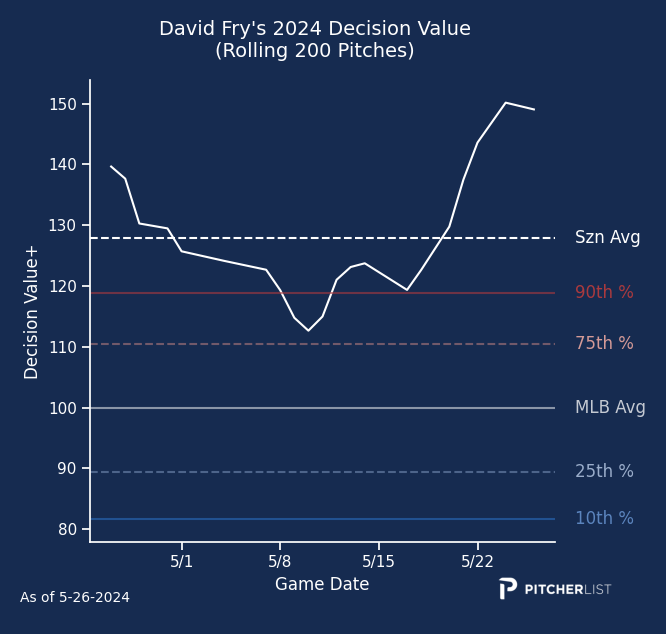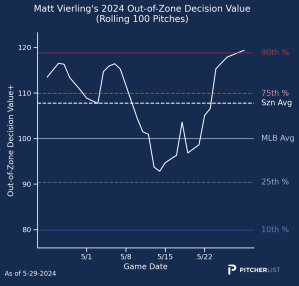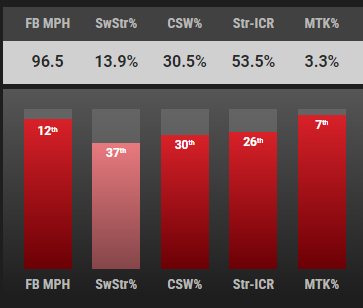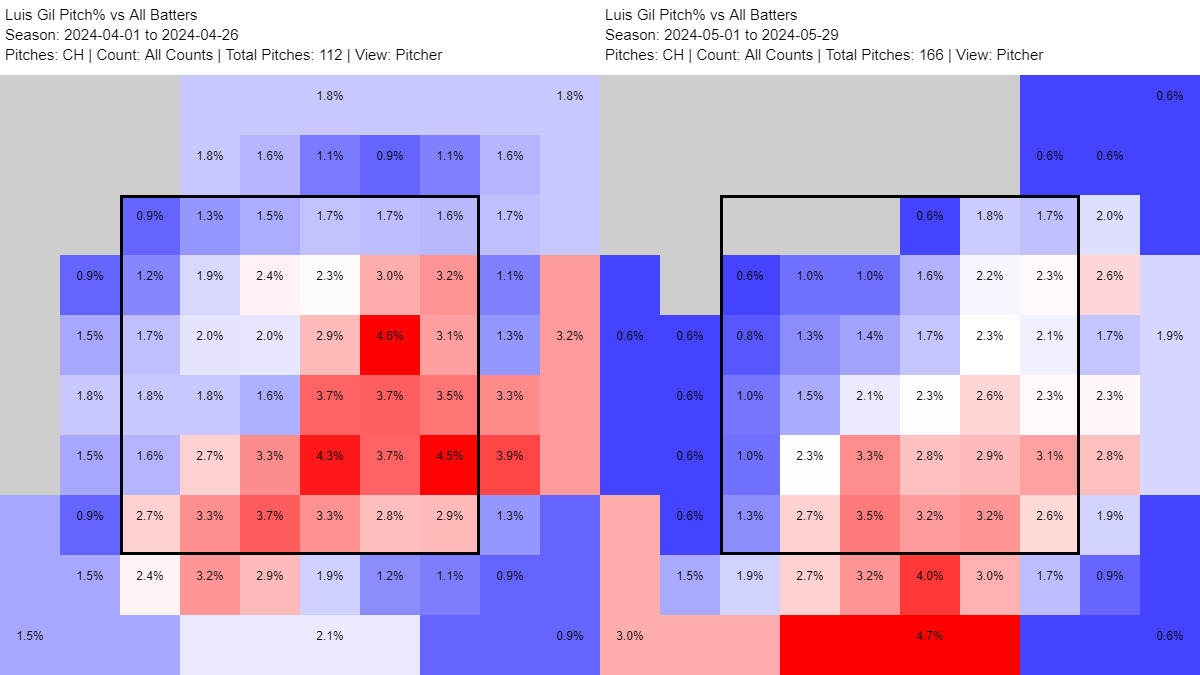The calendar has flipped to June and with 10 weeks under our belt, we’re already nearing the halfway point of the fantasy baseball regular season. Can you believe it?
Hopefully, your team is sitting pretty near the top of your league standings, but no matter how the first 10 weeks have gone, you have plenty of work to do to keep your team on a path to the playoffs and a hopeful league championship. Today we’re diving into three of the game’s hottest players to see if they can keep up their recent hot streaks or if they’ll come crashing back down soon enough.
David Fry, C/OF, Cleveland Guardians
Fry’s been on my shortlist for this article pretty much all season long, and it’s now well past time that we spend some time diving into the extraordinary numbers Cleveland’s red-hot bat is putting up. Fry’s currently slashing an unbelievable .355/.493/.636 with eight home runs, 27 runs, 27 RBI, and four stolen bases. Fry hasn’t just been excellent, he’s been the best run producer in baseball. His 217 wRC+ sits at the top of the leaderboard for any hitter with at least 140 plate appearances.
The incredible start from Fry had been largely ignored in fantasy leagues until the last week or two when his production has been too big to ignore, and I understand why. Fry, who is just now getting a legitimate big-league opportunity at 28 years old, never had a presence on prospect lists and is primarily a catcher. When you have that kind of profile with a player almost no one was familiar with 10 weeks ago, it’s easy to dismiss the hot start as unsustainable without much thought.
Well, doing some analysis paints a pretty great picture of Cleveland’s new-found slugger. Fry is making top-tier contact. His 9.6% barrel rate and 44.6% hard-hit rate are both near the 70th percentile. Not only is he hitting the ball hard, he’s hitting it in the most desirable spots. His 42.2% LA Sweet-Spot% is 94th percentile. Put that all together and you have contact that Statcast adores. His Stacast X stats are all 75th percentile or better: a .392 xwOBA, .278 xBA, and .464 xSLG.
Even when Fry isn’t making contact, he’s putting up production with baseball’s best. His 19% strikeout rate is just slightly above average but he pairs that with a 16.9% walk rate, a top-10 mark among hitters. Even more encouraging is that his strong plate discipline metrics go even further than those surface-level stats. PLV grades him as one of the best swing decision-makers in baseball.

Fry always had solid walk-to-strikeout numbers throughout his journey through the minor leagues, but his swing decisions have improved massively in 2024. I love this stat FanGraphs’ Dan Szymborski pointed out on Twitter: Fry’s in-zone swing percentage has remained relatively the same from 2023 to 2024, but he’s essentially just stopped swinging at balls. He offered at 38.5% of pitches outside of the strike zone in his MLB debut season last year but has cut his Chase% all the way down to 20.2% this season.
Everything looks rather sustainable from the Guardians’ breakout bat, and even projection systems love what he’s doing which is pretty incredible. Projection systems are known for their penchant for playing it safe and not overreacting to a player’s decline or breakout very quickly, but comparing Fry’s pre-season projections to in-season projections is night and day. Nearly every single projection system housed on FanGraphs has given Fry a generous production jump, most notably ZiPs has moved his projected slash line from .238/.305/.399 before the season to .260/.345/.443 moving forward. THE BAT X shows similar changes from .233/.294/.386 to .249/.321/.428.
Verdict: Legit. Fry isn’t going to keep up his 1.000+ OPS throughout the season, but he’s proven himself as worthy of a roster spot in nearly every fantasy format. One thing to watch is his playing time moving forward. Fry’s largely been playing left field recently but with Steven Kwan back from the IL, Cleveland will have to find new ways to get Fry at-bats. The most likely scenario is that he takes over starting catcher duties from Bo Naylor, but he could rotate into the DH role when he’s not behind the plate. Regardless of where he plays, there’s no way they’ll keep his bat out of the lineup.
Matt Vierling, 3B/OF, Detroit Tigers
In his fourth season at the big league level, Vierling looks like he’s finally coming into his own as a productive hitter. In 188 plate appearances this season, Vierling is slashing .294/.324/.503, good for a .356 wOBA and 132 wRC+. He’s really gotten it going the last two weeks especially. His 246 wRC+ over that time is the fourth-highest in the sport.
Vierling’s surface-level plate discipline statistics look very similar to what we’ve come to expect from him, but digging a little deeper we can see some improvements. Even though his 21.8% strikeout rate and 4.4% walk rate are his worst since his 77 plate appearance cup of coffee with the Phillies in 2021, Vierling’s significantly cut back his chase rate. In the first three seasons of his career, Vierling maintained chase rates just below 30%, but he’s moved that down to 19.6% in 2024. PLV has really been impressed with his swing decisions on pitches outside the strike zone.

What makes Vierling’s gains in his chase rate more impressive is that his overall swing rate has stayed nearly identical to where it was in the past, meaning Vierling’s gotten much better at identifying pitches. He’s not just swinging less overall.
While there have been notable gains in swing decisions, on contact, Vierling’s numbers look very similar to what we’ve seen from him in the past.
It’s nice to see Vierling barreling pitches more often while also pulling the ball at a higher rate. Doing both of those things is a great way for any hitter to get to more of his natural power, and he’s doing it without a sky-high flyball rate that can lead to many easy outs. Vierling’s 29.8% line drive rate is 95th percentile and goes a long way in explaining his .341 BABIP making it a little more sustainable than you’d otherwise think.
Although Vierling’s made some improvements to his contact quality, a lot of those numbers are simply middle of the pack. Statcast gives him a .324 xwOBA and .278 xBA while our metrics here at Pitcher List give him a .317 xwOBA and .259 xBA.
Verdict: Better, but not fully legit. Vierling’s strong 2024 numbers are nice to see but I don’t expect he’ll finish the season anywhere near his current 132 wRC+. He’s made some improvements to his profile to be sure, but seeing that he came into the year with a 94 career wRC+, I’m choosing to view him as more of a 105-115 wRC+ hitter moving forward. That’s usable in deeper fantasy formats and likely borderline rosterable in 12-teamers. Regardless of whether you buy into Vierling’s strong play as of late, he’s settled into the leadoff role in Detroit and should see as much playing time as he can handle with Kerry Carpenter’s injury. That lineup spot and opportunity for playing time make him an interesting pickup and give him some solid run-scoring upside.
Luis Gil, SP, New York Yankees
Gil’s season has been the definition of dominant. He’s 7-1 with a 1.99 ERA, 0.93 WHIP, and a 31.7% strikeout rate, and he’s only gotten better as the season’s progressed. He’s on a torrid stretch right now of six straight quality starts and has a 0.70 ERA over those 38.2 innings.
Now, with any insanely good stretch, there is some luck involved. In his last six starts, he has an otherworldly .145 BABIP allowed and has stranded 99.1% of baserunners. It doesn’t matter who the pitcher is — it could be the peak talent of Jacob deGrom with the durability of Cal Ripken Jr. — no one can keep up rates at that level, so yes, Gil’s phenomenal run will end. The real question is what we’ll see from him after that.
Gil’s a prototypical high-stuff, low-command type that can make even great hitters look silly yet have starts where he can’t find the strike zone. Just look at this nastiness from his player page.

During this successful run, as you’d expect, Gil’s had better than normal command. He has an 8.5% walk rate (just a hair worse than the league average) during this hot streak as compared to a 17.6% walk rate in the first five starts of his season.
One of the biggest changes you can see between his mediocre April and lights-out May is his changeup location. He’s done a much better job keeping the offspeed pitch down and it’s paying off big time. He’s using the pitch often early in the count and then bringing it back again with two strikes. His changeup has a 24.3% PAR which is 81st percentile.
His changeup locations from April are on the left. You can see how the pitch wasn’t getting as low as he wanted and running arm-side back into right-handed batters. His locations from May are on the right. It’s a clear and massive improvement with his changeup living right at the bottom and even below the zone.

While his changeup is nice, it’s not the highlight of Gil’s arsenal. That would be his electric four-seamer. He turns to the pitch more often than almost any other starter in baseball but for good reason. Gil sits 96.5 mph on his four-seamer, a velocity in the 94th percentile of all starters. PLV likes the pitch quite a bit, grading it at 5.14 which is 70th percentile. Other Pitch Models agree that his fastball is one of the best. Stuff+ grades it at 127 with 100 being average. Gil’s four-seamer is the 7th best among starters according to Stuff+. PitchingBot grades it similarly with a 65 on the 20/80 scale, this time good for the 6th best four-seamer among MLB starters.
It’s great to see pitch models love a pitch, but the results it gets are what’s most important, and Gil’s fastball stands out there as well. Its 32.7% CSW% is in the 91st percentile and when hitters do make contact, they’re hitting the pitch to the tune of a .134 batting average and .235 wOBA.
Gil rounds out his arsenal with a slider he throws sparingly; just 17% of the time. Pitch models have mixed feelings about Gil’s breaking ball, with PLV grading it well below average while both Stuff+ and Pitching Bot see it as a solid offering. Gil’s scatterplot of his slider location isn’t great. You can tell he struggles to locate it consistently. Unlike most pitchers who keep their slider glove side and low, Gil’s has arm side and high location rates both above the 75th percentile.
When you put it all together you see a picture of an arm that has the potential to be a top-20 starter in baseball. Gil’s command is hard to trust and we can see that a bit in his PLV stats. His Q-BP%, or quality pitch rate minus bad pitch rate, is 15.7% which is only in the 39th percentile among big league starters.
Verdict: Legit with scary downside. If you’re rostering Gil, I’d hold on unless someone makes you an offer you can’t refuse. He has immense talent, but whether or not his command will hold throughout the season is a gigantic question mark. I view him very similarly to an arm like Hunter Greene. There’s massive upside but also a scary floor that we can see a little too clearly.
Featured image by Doug Carlin (@Bdougals on Twitter)
